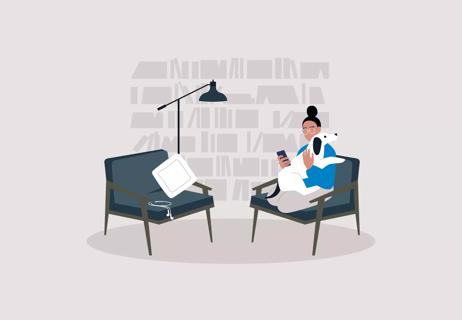The answer comes down to your child’s maturity

Navigating life in the digital age can be confusing. While we love to stay connected to friends and family and stay up-to-date on the latest headlines, it can sometimes be too much of a good thing. When you’re always online or plugged in, you run the risk of missing out on important things happening in your physical space — not to mention the built-up stress from being overwhelmed with bad news and the newly termed habit of doomscrolling.
Advertisement
Cleveland Clinic is a non-profit academic medical center. Advertising on our site helps support our mission. We do not endorse non-Cleveland Clinic products or services. Policy
But if you’re a parent, chances are your kids are scrambling to get online. At school, they’re probably privy to a whole bunch of technological advances in the classroom and the social pressure of getting online in order to fit in. If your kids are asking for a smartphone, how do you know if they’re ready, and how can you prepare them for the World Wide Web and all of its dangers?
Pediatrician David Hornick, MD, shares how you can tell if your child is ready for a smartphone, along with tips to make introducing a smartphone easier.
In today’s world, Dr. Hornick says it’s acceptable to buy your child a smartphone between 12 and 14 years of age. But those aren’t magic numbers; your child’s maturity is what matters.
“Phones are fun, but they’re a tool we use for certain activities and certain amounts of information and communication,” says Dr. Hornick. “If your child is spending a lot of time outside of the home — like if they’re on a team for school or they have regular after-school lessons — and they’re becoming more independent, a smartphone might be a good idea.”
For kids younger than 12, or kids that spend a lot of time at home and aren’t quite as independent, a regular phone that just allows your child to call or text might be the best way to go until they’re older or getting out of the house more often. For one, it’s good to have if there’s ever an emergency or they need to reach you. But younger kids also have less of a filter.
Advertisement
“The frontal part of our brains, the prefrontal cortex, acts as a filter and helps us rationalize decisions,” explains Dr. Hornick. “When the impulsive part of our brain says, ‘You should send Johnny a nasty message,’ the prefrontal cortex says, ‘No, that’s not a nice thing to do.’ The younger you are, the less effective that part of the brain is.”
In fact, our prefrontal cortex isn’t fully developed until we’re in our 20s, and that’s why teens can do the most irrational things. If your child has a hard time processing the dangers or risks of having a smartphone and if they’re unable to follow the rules you put in place, they may not be ready.
There are two sides to every coin. That’s true for most big life decisions, and that’s especially true when deciding whether or not to let your kid have a smartphone. Here’s a breakdown of the bigger pros and cons of giving your kid a smartphone.
Like most technological advances, smartphones are designed to improve your connectivity to the world and provide unlimited access to information at the press of a button. If your kid has steady access to the internet at home and school, and they’re following the rules when utilizing those tools, the chances of them using a smartphone effectively are high.
But, Dr. Hornick says, using a smartphone for research isn’t a selling point for most kids. “Surfing the internet, getting information on things, I think that’s a vanishingly small percentage of what they’re going to use their phone for,” he notes. Instead, kids are more interested in using their smartphones to fit in with their friends, connect with others online and for entertainment.
Just like driving a car for the first time or being dropped off at a friend’s house or social event, having a smartphone can boost your kid’s ability to feel empowered and independent. The more time they spend outside the home, the more inclined they’ll be to take matters into their own hands.
“If they have that connection and ability to contact their parents or friends, that’s going to give them some confidence about being on their own,” says Dr. Hornick. “It will help mature them and turn them into being more responsible about themselves and their relationships with their parents if they’re given the tools to maximize on those opportunities.”
The internet is vast, and with it comes a variety of social media platforms that can be toxic when used to harm others. Cyberbullying is particularly problematic among younger smartphone users. It’s important to talk to your kid ahead of time about not participating in such negative behaviors, as well as to prepare them for how to handle it when it happens to them. Other dangers of social media include:
Advertisement
“The potential for abuse and the potential for bullying and doing other inappropriate things is very high,” stresses Dr. Hornick. “But there are a lot of social pressures for not joining social media if you’re entering high school or even the latter part of middle school. Part of joining the club is belonging to platforms like Instagram and Snapchat.”
Like a shiny new toy, a smartphone has infinite capabilities. In one tiny device, you have the ability to stream videos, watch movies, play games, connect with friends and read all kinds of material. If left unchecked, becoming dependent on the technology can become a real issue that interferes with everyday life. “Becoming dependent on any technology can be fraught with problems,” says Dr. Hornick.
If you’ve weighed your options and have decided to go the smartphone route, here are a few tips to help your child benefit the most from it.
The major control you have in this situation is setting limits on how your child can use their smartphone. Parental controls can be put in place to limit certain websites or social media platforms. At most, Dr. Hornick suggests allowing one or two social media accounts until your child has proven they can use them effectively and in a positive way. “When you’re on four or five different platforms, it can get too engrossing and way too much for them to handle,” he cautions.
Advertisement
Putting time limits in place is also important: You want to make sure the phone is turned off at bedtime, or at the least, plugged in outside of their bedroom. Although your kid might fight to use their phone as an alarm, you should use a different alarm instead because using a phone before bed can actually interfere with your ability to sleep.
You can also limit the amount of time they spend on their phones overall, as well as time allowed on specific apps, by setting up screen time limits with parental controls. You might also consider creating phone-free zones where using the phone by anyone (including you) is frowned upon. A phone-free zone could be enacted during meals, at family get-togethers or during special events. The idea is to maximize your child’s participation in the important activity that’s happening.
“It’s important for children to have a relationship with their parents that involves talking and sharing time together,” says Dr. Hornick. “Phones take away from the intimacy and time you spend together, and sometimes, parents are just as guilty in many cases as children for being on their phones too often.”
By creating a contract together on rules and expectations for a smartphone in advance, you and your child are holding each other accountable for the exciting new journey ahead.
Advertisement
Both you and your child should sign this contract, and it should be visible at all times. Maybe even hang it on the fridge. This also allows your rules and expectations to be particularly clear and defined so there won’t be any mix-ups if things ever go sideways. And if you can’t both agree on how a smartphone will be used, then they’re not ready.
“Making sure you’re sitting down and ensuring your child understands these things will help you make that decision as to whether your child can have a smartphone or not,” says Dr. Hornick.
Putting healthy boundaries in place is important, but part of having a smartphone is trusting your child to respect the boundaries and expectations you’ve both decided on together. As a parent, you might have every right to go through their phone at any point — after all, you probably float the bill and if they’re not doing anything wrong, they probably don’t have anything to hide.
But if you don’t have a good relationship with your kid and they don’t regularly share details of their social life with you on a daily basis, looking through their phone will feel like a huge invasion of privacy. Dr. Hornick suggests that kids under 15 or 16 need that extra supervision to allow their parents to help them make decisions and to remedy their mistakes. But kids older than 16 may need a little more freedom because with maturity comes trust.
“If you have a good relationship with your child and you talk about the things they’re doing with their phone and their friends, then it might be fine to look through their phone,” advises Dr. Hornick. “When they get to be 16, 17 or 18, there are some privacy issues where it may not be appropriate for parents to read some of those things.”
Use this opportunity to bring back those conversations you had with your kid earlier in life about the dangers of strangers and alerting someone when something goes wrong or if someone makes them feel uncomfortable. They might already be familiar with the idea of sexting, but it’s important to check in with them and let them know that it’s never OK to send explicit texts or pictures of themselves to friends or people they don’t know online. This may be more of an issue with younger kids than older ones, but it’s still an important issue to address either way.
“Just like you don’t talk to strangers and get into their car, there are things that can happen in the same way with strangers online. The problem is, strangers online have methods where they can get you to do stuff that you don’t really want to do or don’t do by mistake,” Dr. Hornick adds.
We’ve all heard the adage: What happens online stays online forever. But if mistakes happen even after you speak to your kids about what’s acceptable behavior and how best to use their smartphone, it’s not the end of the world. What’s most important is that you treat each mistake on a case-by-case basis as an opportunity to reinforce the limits you’ve put in place and that you support them through those lessons by being there for them.
“You’re exposing them to something that’s very addictive, and when they don’t have the ability to control themselves, they can get themselves into trouble,” says Dr. Hornick. “Parents have to be on top of things and they have to be willing to mitigate situations as they happen.”
Learn more about our editorial process.
Advertisement

It isn’t a recognized mental health disorder, but research shows that problematic social media use can negatively affect your mental health, self-esteem and sleep

This trendy practice may boost your physical and mental health — but done incorrectly, it could make things worse

They’re fun to watch, but medical TV shows are often more hype than reality — and you shouldn’t rely on them for factual medical information

Embrace mindfulness and practice checking your phone consciously, not compulsively

Identify your triggers, set ground rules for your break and start practicing mindfulness

Too much screen time and unrealistic expectations and perceptions and can lead to an increased risk of anxiety and depression

Talk to your child about the dangers these viral videos pose to their health

Frequent smartphone use can lead to painful issues

Start having sex about 72 hours before ovulation, then at least every other day during your fertile window

Attachment theory suggests that your earliest relationships shape connections throughout your life

It isn’t a recognized mental health disorder, but research shows that problematic social media use can negatively affect your mental health, self-esteem and sleep